Dye Diet Calculator: Food rating systems at a glance
How to find healthier food?
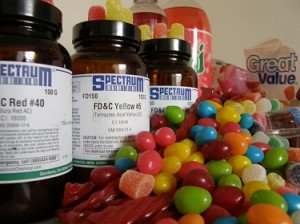 Naturally and by definition, food is nutritional substance. Anything else is not food. The more food additives it contains the less food it is. We have over 3000 food additives in the American food supply. In 2012 year alone, there were more than 25 million pounds of the artificial colors allowed into our and our children’s food. No surprise, it’s easy to get confused about which product is food and which isn’t. Or even worse, it’s easy to get chronically intoxicated or develop metabolic syndrome. That’s exactly where we are now. If you want to survive to your old ages, you better learn how to find healthier food now. You better… read labels. I know, I know – ingredient lists look too technical to majority of consumers unless you are a professional chemist, like me.
Naturally and by definition, food is nutritional substance. Anything else is not food. The more food additives it contains the less food it is. We have over 3000 food additives in the American food supply. In 2012 year alone, there were more than 25 million pounds of the artificial colors allowed into our and our children’s food. No surprise, it’s easy to get confused about which product is food and which isn’t. Or even worse, it’s easy to get chronically intoxicated or develop metabolic syndrome. That’s exactly where we are now. If you want to survive to your old ages, you better learn how to find healthier food now. You better… read labels. I know, I know – ingredient lists look too technical to majority of consumers unless you are a professional chemist, like me.
The biggest confusion: Ingredient lists
Even more confusion comes from numerous synonyms used in careless manner. For instance, you can see “modified corn starch,” a common emulsifier, under all its imaginable nick names: modified cornstarch; cornstarch modified; corn starch-modified; corn-starch modified, etc. Perhaps we all know what starch is but what “modified” supposed to mean? Simply put, it is a native starch which underwent partial hydrolysis with hydrochloric acid or sodium hydroxide or with other methods. What you say, is it clear now? Do you understand how the modification affects nutrition and toxicity? Well, it’s clear enough for a professional chemist but I doubt that it’s clear for millions of consumers of chips, snack bars, candies, yogurts, ice creams, etc. Obviously, there is a need for a tool which would translate all the technical information to consumer-friendly language in terms of health and nutrition. With this goal in mind, many food rating systems were created. However, it looks like even those who design them often show signs of confusion.
Food rating systems: More confusion?
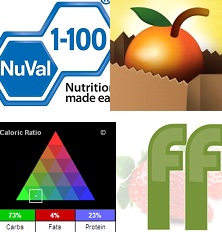 Typically, approaches such as NuVal scoring system, Fooducate grading system, Shop Well or Food Facts score and others include subjective scales where 100 units (or A-grade, green) are assigned to some sort of arbitrarily chosen food product considered as nutritionally best whereas 0 units (or F-grade, red) are arbitrarily assigned to a nutritionally worst one. Obviously, if a new (better or worse) product enters the market, it will stay aside of the range. Also, a variety of foods fall into a broad “good” or “bad” ranges for reasons which are not always easy to understand.
Typically, approaches such as NuVal scoring system, Fooducate grading system, Shop Well or Food Facts score and others include subjective scales where 100 units (or A-grade, green) are assigned to some sort of arbitrarily chosen food product considered as nutritionally best whereas 0 units (or F-grade, red) are arbitrarily assigned to a nutritionally worst one. Obviously, if a new (better or worse) product enters the market, it will stay aside of the range. Also, a variety of foods fall into a broad “good” or “bad” ranges for reasons which are not always easy to understand.
Confusion and inaccuracy are not uncommon in the food rating systems. For instance, Food Facts lists MSG as an allergen in Great Value Light Fat Free Vanilla Yogurt which contains no MSG at all. Also, it’s hard to understand why, for instance, processed fat free skim milk gets highest possible grade green A (93 – 100) whereas all-natural Brown Caw Non-fat Greek Plain Yogurt gets only green B+ (77 – 84). Examples continue on and on.
Another common confusion often results from lack of understanding of where trans-fats come from and from missing the fact that trans-fats occur naturally too. Also, there is a widespread confusion about which food ingredients can and cannot be affected by genetic modification. As a result, GMO stigma is often erroneously expanded on fats, soy lecithin, HFCS, corn starch etc., instead of being attached only to DNA- and protein-containing food additives.
While they may be based on different criteria, all food rating systems I am aware of have a lot in common:
- They subjectively rank food to express nutritional value of food;
- Consequently, there is no rational relationship between scores and nutritional qualities of food ingredients;
- Inherent subjectivism allows for inaccuracy and more confusion;
- Plenty room for manipulations.
The Dye Diet Calculator is rising from a different concept which is still in development. Therefore it’s free from many above mentioned drawbacks.
How the Dye Diet Calculator is different?
Current version of the Dye Diet Calculator is focused mostly on addressing the issue of food additives. In other words, it’s focused on processed food and it doesn’t embrace whole foods and produce, where in my opinion there is very little or no confusion about nutritional worth. Furthermore, how can you state that, say, almonds are forever nutritionally richer than melon on one of these hot summer days? What would you choose: almonds to die of dehydration or a slice of melon to survive? This example demonstrates that nutrition value of whole food depends on your body needs. The situation with so many food additives is quite different: your body never ever needs them.
Although the Dye Diet Calculator doesn’t take into consideration nutrition facts, caloric and sugar contents are among the information you get. Moreover, every calculation result provides you with a reference to another website like Calorie Count, My Fitness Pal, Fooducate, etc., from where you can obtain additional data.
In comparison with other food rating systems, the Dye Diet Calculator is based upon one step deeper approach:
- It ranks food ingredients with regard to their chemical structure, nutritional and toxicological data and then;
- Calculates health risk and nutritional values of food with use of special algorithm.
There are a number of useful consequences that follow from the way the calculator is built and how it operates:
- List of ingredients is all you need to obtain nutritional value of any food product;
- Objectiveness and independence allow for verification of other systems;
- The Dye Diet Calculator protects your interests no matter how convincing false marketing claims may seem: The truth is decoded from ingredient lists;
- You don’t have to understand meaning of ingredients;
- The Dye Diet Calculator is an interactive tool: You can introduce any product of your choice and calculate its health risk and nutrition for yourself.
Therefore, I do believe that the Dye Diet Calculator is a useful tool complementary to the existing approaches that you can use to benefit your health in the most effective way. Let’s see how a number of food rating systems perform in assessing of two randomly selected food products: corn chips and a drink.
Fritos Chili Cheese flavored corn chips
On the label it reads: “When hunger strikes you want something that’s going to hold you over and keep you satisfied.” All right, let’s take a closer look at what exactly is inside.
Quick glance at the ingredients told me that, at least, there are no artificial colors. Perhaps, I thought, the corn chips are relatively safe. Accordingly, the Dye Diet Calculator gave Health Risk = 0.16 (Low) and Nutritional Value = 1.13 (Moderate), the value ranges of a product you can safely eat in moderation. Only caramel color is a food additive to avoid. Not bad at all! (Please NOTE: To see the result in the calculator you will have to start typing-in word ”fritos” and choose from suggestions).
Surprisingly, Fuducate, Food Facts and Shop Well all gave equally poor scores for Fritos Chili Cheese corn chips: red D, red F (0 – 9) and 39 red correspondingly. whereas Nutrition Data and NuVal were of no use (see Table 1).
Table 1. Fritos Chili Cheese flavored corn chips
|
Fuducate |
Food Facts |
ShopWell |
Nutrition Data |
NuVal |
Dye Diet Calculator |
| Red D | Red F (0 – 9) | 39 Red | no results | no results | Health Risk = 0.16 (Low)Nutritional Value = 1.13 (Moderate) GOOD |
|
Wrong ingredients |
Wrong ingredients |
Wrong ingredients |
No ingredients; Inconvenient search |
No ingredients; Inconvenient search |
Correct ingredients |
Quick research revealed that all three “bad” results are relying on the same wrong list of ingredients which includes partially hydrogenated soybean oil and artificial color. In addition, all three lists include “whole corn” which does not present in the actual list on the package.
As the consequence, all the three food rating systems provide you with the same dramatically undervalued nutritional outcome that is certainly misleading to all consumers who look for healthier corn chips. At first I assumed that this was just one unfortunate isolated issue but the next randomly selected product has proven the otherwise.
Fun Pops Fruit Flavored Freezable Beverages
I knew from the beginning that Fun Pops is just a fruit fraud and chemicals waste. Indeed, the Dye Diet Calculator clearly indicated unacceptably high health risk and unacceptably low nutritional values.
But, wait! Below is another surprise waiting for you: Fooducate rating for Fun Pops is very high, Green B+ (see Table 2). Is this by mistake, perhaps? Anyway, I would like to strongly discourage children from drinking Fun Pops!
Table 2. Fun Pops Fruit Flavored Freezable Beverages
|
Fuducate |
Food Facts |
ShopWell |
Dye Diet Calculator |
|
Incorrect ingredient: “benzoate of soda” |
Incorrect ingredient: “benzoate of soda” |
Incorrect ingredient: “benzoate of soda” |
Correct ingredients |
All right, relax! At least the two other food rating systems do not praise the junk drink too high! Still, I do not understand why ShopWell rates this chemical fluid a little higher (40 yellow) than discussed above Fritos Corn chips? Do you?
Again, after closer look, I have found that the ingredients presented by all the three are identical and all contain the same mysterious food additive <<benzoate of soda>> which is a nonsense that doesn’t exist on earth. As a chemist, I can guess that <<sodium benzoate>> should have been listed instead. But not all consumers are chemists!
This has led me to a conclusion that at least these three food rating systems are seemingly built upon the same database and so they often inherit the same errors and breed the same confusing results which may mislead unprepared consumers. But not me, though!
In place of epilogue, I would like to conclude with a slogan quoted from Fooducate: “Eliminate nutrition label confusion!” Indeed, let’s work together; let’s try and test all available food rating systems in our struggle for healthier food. Let’s eliminate not only confusion but also myriads of health-damaging food additives from our diet. Let’s go, get off the “dye diet”!
Category: American diet, Dye Diet Calculator, Healthy diet

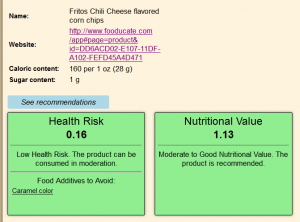
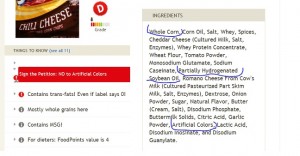
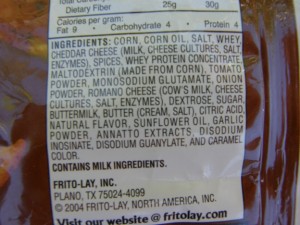
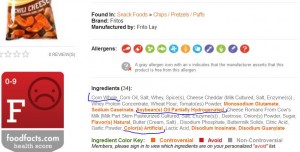
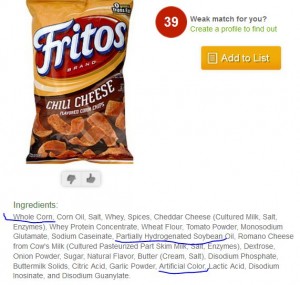
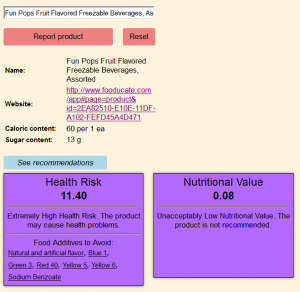
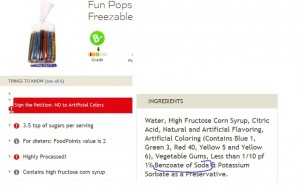
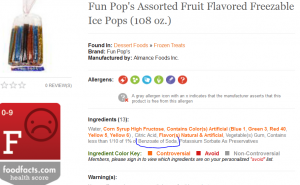
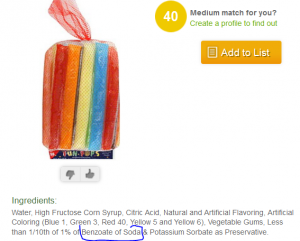




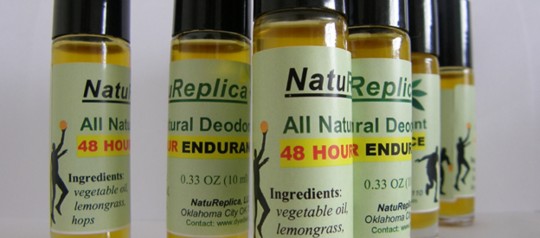
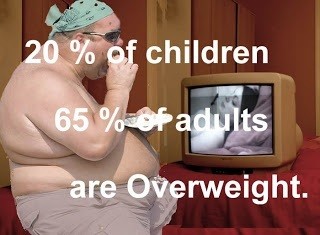
Why don’t you test each food and study a manufacturer’s claims before you assign a star rating?
Well, I do check claims but I do not assign “star rating.” Manufacturer’s claims are often just marketing tricks. The Calculator gives you Health Risk and Nutrition values of products based on ingredient lists. There is no need to physically test every product to evaluate the two parameters.
Most of the rating systems were created by food manufacturers or supermarket chains. Don’t forget that their goal is to sell you more food, not less. So take their recommendations with a grain of salt.
Agree. But the Dye Diet Calculator stands out. It represents quite different approach developing by a professional chemist.
Two new numerical food-rating systems — the NuVal Nutritional Scoring System and the Aggregate Nutrient Density Index (ANDI) — are attempting to simplify matters. Piloted in some Kroger and Whole Foods Market stores, respectively, both share a common goal of streamlining the process of evaluating various foods’ nutritional merits. Although they differ in their approach and delivery, both systems ultimately distill the nutrient density of each food into a single numerical score.